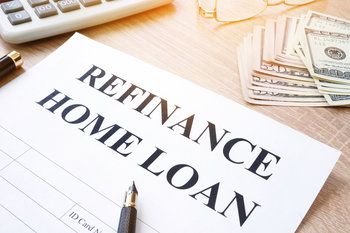 Updated by Keith Gumbinger
Updated by Keith Gumbinger
While mortgage refinance rates may not be very favorable at the moment, there can still be reasons for considering a cash-out refinance. While it of course would be better to be able to get money out of your home and get a lower interest rate and lower monthly payments, that doesn't mean that cash-out refinancing can't still be valuable.
What is a cash-out refinance?
Unlike a "rate-and-term" refinance, where the homeowner's goal is generally to get a lower interest rate and monthly payment, a cash-out refinance sees a homeowner replace an existing mortgage with a new loan that has a larger loan amount. The difference between what remains on the existing loan and the amount of the new mortgage is the "cash-out" component. As the homeowner's goal here is tapping equity in the home, the interest rate and payment on the new loan may or may not be lower than the original loan.
Can I do a cash-out refinance to a higher interest rate?
You might think it crazy to consider a cash-out refinance to a higher mortgage rate. After all, doesn't that mean the monthly payment will go up?
Well, it might or might not. What matters here is how far along you are in your existing mortgage, how large is the step up in interest rate to the new mortgage, how much cash you need to reach your financial goal, how long you'll be paying the new mortgage before refinancing again or selling the home, what your other options for borrowing funds may be (and interest rates on those loan options) and what you are doing with the new funds you borrow.
Here's a scenario. Let's say you have $12,000 in credit card debt carrying a 19% interest rate. Your minimum payment is interest due plus 1% of the outstanding balance; this would be about $310 per month.
You have an existing 5% mortgage with an original $100,000 balance taken out seven years ago. The current remaining loan balance is $87,945 and carries a $537 monthly payment.
A new mortgage is available in the market at 6%. You can do a cash-out refinance back up to your original loan amount -- back to $100,000 -- and take out $12,000 in cash to pay off your credit card debt. Your new monthly mortgage payment would be $599.55. Yes, your mortgage payment will go up; however, instead of two payments totaling $847, you have only the one of $599.55 -- and you have improved your cash flow by $247 per month.
Even at 7%, your monthly payment would be $665, and your financial situation would still be improved by $182 per month.
It's important to remember that this is only a cash-flow improvement; total interest cost over time may end up being as high or even higher than the original mortgage and credit card interest combined. With this in mind, you'll want to pay attention for opportunities to do a rate-and-term refinance in the future to lower your interest rate again.
The point is, and while a lower rate would be better, it's entirely possible to find scenarios where a cash-out mortgage refinance to a higher interest rate can prove valuable.
Cash out refinance vs home equity loan
A cash-out refinance is different from a home equity loan or line of credit.
In a cash-out refinance, you refinance an existing mortgage loan with an even larger loan. You can take the difference between the old and new loans and spend the extra money however you see fit.
By contrast, a home equity loan is a separate loan that rests on top of your mortgage loan. Usually fixed-rate loans, these provide a lump-sum of cash at closing, and then you make payments over a fixed term. These payments are in addition to your regular monthly mortgage payment.
A home equity line of credit (HELOC) works more like a credit card. Home equity lines allow homeowners to borrow and repay funds over time. Repayment terms for home equity loans and lines of credit are usually shorter than first mortgages, often not longer than a total of 20 years.
Including your first mortgage, most home equity loan programs let you borrow up to 80 percent of your home's value. The combination of your first mortgage and your second mortgage as a percentage of the value of the property is known as your total loan-to-value (TLTV) ratio. Some lenders may allow you to go up to 85 TLTV or more of the property value.
Since home equity loans and lines of credit are second mortgages -- that is, they are in a subordinate lien position to your first mortgage -- they present different and greater risk to the lender. More risk means higher interest rates, and second-lien interest rates are typically higher (sometimes considerably so) compared to first mortgages.
Depending on the bank or mortgage lender, by using a home equity loan or line of credit you may be able to leverage slightly more money from your property as opposed to a cash-out refinance. However, in general, a cash-out refinance may give you a better interest rate and longer available loan terms than a home equity loan. Since it's one loan, a cash-out refinance means you also only have a single monthly mortgage payment to make.
How much cash can I get with a cash-out refinance?
While the percentage can vary according to the type of refinance program, lenders typically allow you go as high as 80 percent of your home's value for your cash-out refinance. The amount of equity you have and will be able to access when doing a cash-out refinance is determined by the appraised value of your home and the remaining balance of your existing mortgage. And, of course, you have to qualify to borrow the money, so the amount you can get may also be limited by your credit score, income and debt-to-income (DTI) ratio.
With a conventional loan you can go up to an 80% loan-to-value ratio (LTV) for a cash-out refinance. After a change in August 2019, the Federal Housing Administration (FHA loans) now caps FHA cash-out refinances at a maximum 80% LTV (down from 85%) too.
Veterans Administration-backed loans (VA loans) can allow for cash-out refinancing of up to 100% of the property value. If you have VA eligibility and need access to your equity above the 80% level, this might be an option to explore.
LTV requirements change over time, and lenders making loans in the non-qualified mortgage (non-QM) portion of the market may have programs that allow for higher LTVs. Once consideration in doing a cash-out refinancing where the loan-to-value ratio exceeds 80% is that you'll likely be required to pay Private Mortgage Insurance (PMI) again.
For example, if your home's value is $400,000 and you owe $300,000 on your first mortgage, you have $100,000 of home equity.
However, and unless you're using a VA loan, you won't be able to borrow 100% of your home's value. Using this scenario, if you were trying to maximize the amount of cash you could receive via a cash-out refinance, you could likely opt for a conventional loan if your credit is great or an FHA-backed loan if you're further down the credit scale.
Here's a more detailed example of this cash-out refinance scenario at a loan-to-value of 80 percent:
Before Cash-Out Refinance
$400,000 = appraised value of home
$300,000 = current mortgage balance
$100,000 = existing home equity
After Cash-Out Refinance
$400,000 = appraised value of home
$320,000 = new mortgage balance
$80,000 = updated home equity
$20,000 = cash available to you
Should you do a cash-out refinance?
Cash-out refinances aren't right for everyone or every situation.
For example, let's say you only need $5,000 or $10,000 cash. If it costs you $5,000 in closing costs just to get access this amount of cash, a cash-out refinance doesn't make financial sense.
Further, if the new mortgage comes with a significantly higher interest rate than what you currently have, and you're not planning to sell your home within the next year or so, a cash-out refinance may not work well for you, since higher total interest costs will accumulate over time. To make such a higher rate cash-out refinance work, you would likely need to sell or refinance again when lower rates become available.
In the best situation, you may be able to do a cash-out refinance and lower your interest rate, too. This can be a win-win for many homeowners as you're able to tap into your home's equity and get a lower mortgage rate at the same time.
In fact, and depending on what's happened to the value of your home, how much progress you've made in paying down your existing mortgage, the size of the interest rate break from your old loan to the new one and how much equity you are looking to use, it's even technically possible to do a cash-out refinance, get a fair amount of cash to utilize and still have nearly the same monthly payment as if you didn't do the cash-out refinance in the first place.
Why a cash-out refi?
Homeowners may choose a cash-out refinance for a variety of reasons. For instance, cash-out refinances are popular for doing debt consolidation, where you pay off other high interest debt with the proceeds from the refinance.
For example, if you have credit card debt, student loans or personal loans with higher interest rates, a cash-out refinance could make sense to pay off the debt this way. Just remember that you'll be converting unsecured debt to a loan that uses your home as collateral.
However, keep in mind that after the Tax Cuts and Jobs Act of 2017, the interest on draws of equity not used to "buy, build or substantially improve" your home are no longer tax-deductible. Tax break or not, the lower interest rate from a cash-out refinance compared to other forms of debt may still be able to save you money or at least improve your monthly cash flow and overall personal finances.
Other times where a cash-out refinance can be useful include:
- Home improvements or renovations
- Retiring an existing home equity loan or line of credit
- Investment purposes
- Setting up a 6-month "emergency" fund
- Vacation or travel
- Educational expenses
- "Buying out" a spouse or partner
- Large purchases such as automobiles, RVs, etc.
- Buying a second home, vacation home or investment real estate
Cash-out refinance loans can be ideal for homeowners seeking to tap into their home's equity without selling their home. Even with today's mortgage rates no longer near historically low levels, higher home values could make now a good time to access the equity in your home via a cash-out refinance.
Related: What's the best way to pay for my refinance?




Does the cash out work for modular homes we own or home out right been appraised 120,000 we need to takeout about 30,000 what do you think would this work for us
Need $40,000 in order to pay off credit cards and taxes due to IRS and CA Franchise Tax. Have equity in my home but also have existing HELOC. In 2008 experienced many financial challenges which resulted in the loss of 2nd home in Arizona. However, primary residence mortgage in California is current and has had no late payments. We are working to put ourselves in a better financial situation. Please contact only if you are able to help. Have been put through hoops by lenders who eventually deny us. Thank you